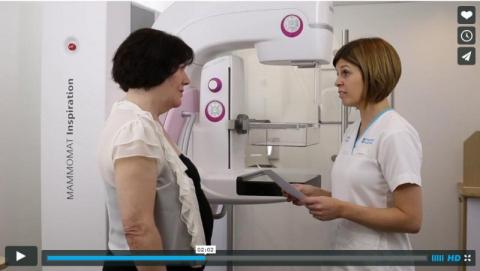New video explains all about breast screening

A new video that shows women what to expect when they attend for breast screening has been produced by the Public Health Agency (PHA). It covers the whole process of screening – from receiving the invitation letter to getting the results. The video is aimed at women who have never attended for breast screening or who have been invited for the first time.
Breast screening mammogragher Claire Clarke from the Northern Health and Social Care Trust who features in the video said: “Some women feel nervous before arriving for their screening, particularly if it is their first time. They are not just worried about the outcome of the screening, but they are also worried about the actual mammogram itself. For some, the imagined experience can be so daunting it can actually put them off attending.
“This video shows women how warm and welcoming the screening units are and they also get to see the digital mammography machine, which is not at all frightening. Hopefully this video will reassure and encourage women to attend for screening.”
In 2012/2013 there were 64,000 women invited for screening across Northern Ireland, of whom 74% were screened.
Dr Adrian Mairs, Quality Assurance Director for the Northern Ireland Breast Screening Programme at the PHA, said: “Most women who are invited for breast screening attend for regular mammograms. Our new video will let women who have never attended in the past see what is involved and I hope it will encourage them to discuss breast screening with their friends and family.”
Most women who attend for breast screening will have normal mammograms. Out of every 100 women who attend for screening about four are asked to come back for further tests. Three out of these four will have a normal result. In 2012/13, a total of 432 breast cancers were detected – that equates to more than one woman per day who previously did not know they had cancer, but who are now getting early treatment.
Dr Mairs continued: “I urge all women who are invited for breast screening to consider attending. I also encourage women over the age of 70 to consider contacting their local breast screening unit to arrange an appointment every three years. Many women don’t realise that the risk of breast cancer continues to increase with age. Breast screening remains the best way we have of detecting breast cancer at an early stage when treatment can be more effective.
“It is also important for women to look out for changes in the appearance of their breasts such as a change in size or outline of either breast, especially those caused by arm movement; any puckering, dimpling or redness of the skin; or veins that stand out more than usual.
“Women should be aware of any feelings of pain or discomfort in one part of either the breast or armpit, particularly if it is new and persistent. Women should also look and feel for any lumps or thickening in either breast that feels different from the other breast, as well as any swelling or lumps under the armpit or around the collarbone. Also look out for any changes to the nipple such as a nipple that has become pulled in, changed shape, has a discharge, bleeds, has a rash or has crusted, flaky skin.
“Many changes are harmless but all should be checked by a GP. If the change is due to cancer, earlier detection may mean simpler and more successful treatment.
“Regular breast screening reduces the risk of death from breast cancer. On average one life will be saved from breast cancer for every 200 women screened.”
The breast screening video can be viewed at: www.bit.ly/phabreastscreening or for further information on the screening service see www.bit.ly/FAQ-breastscreening
Ends
